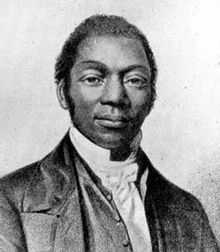James W.C. Pennington

James William Charles Pennington (1807–1870) was an African-American orator, minister, and abolitionist who had escaped at the age of 19 from slavery in Maryland.
Biography
James Pennington was born a slave on the Eastern Shore of Maryland. When he was four years old, he and his mother were given to Frisby Tilghman, their owner’s son, as a wedding gift and moved to a new plantation called Rockland, near Hagerstown in western Maryland.[1] There Pennington was trained as a carpenter and blacksmith.[2] On October 28, 1827, at the age of nineteen, Pennington escaped from the plantation[3] and, after a series of misadventures managed to get into Adams County, where he was taken in by William and Phoebe Wright, who were Quakers and glad to assist a fugitive slave. Pennington was illiterate so Wright began to teach him to read and write. He also adopted the name Pennington, a name famous in Quaker history.[4]
Moving on to Brooklyn a year later, Pennington found work as a coachman for a wealthy lawyer and continued his education, paying tutors out of his earnings, and teaching himself Latin and Greek.[5] He attended the first Negro National Convention in Philadelphia, in 1829 and continued active in the Negro Convention movement, becoming its presiding officer in 1853.[6] Within five years he had learned so much that he was hired to teach school in Newtown, Long Island.[7] He became involved in the Shiloh Presbyterian Church, Manhattan, and was accepted as the first black student at Yale – though with the proviso that he must sit in the back of the room and not ask questions.[8]
Completing his studies at Yale, he was ordained to the ministry of the Congregational Church and served a congregation on Long Island before being called to the Talcott Street Church (now called Faith Congregational Church) in Hartford, Connecticut, in 1840.[9] There he wrote the first black history, became involved in the abolition movement, and was selected as a delegate to the Second World Conference on Slavery in London.[10] Returning to Hartford after being invited to preach and serve communion in English churches, Pennington pressed his white colleagues to include him in their pulpit exchanges and became the first black pastor to preach in a number of Connecticut churches. Becoming involved in the Amistad Case, Pennington insisted that the freed captives must be accompanied by a pastor on their return to Africa and formed the first black missionary society to raise funds for that purpose.[11]
Pennington was called back to New York in 1850 to serve the Shiloh Presbyterian Church but the passage in 1850 of a new and far more stringent fugitive slave law made it necessary for him, still technically a fugitive with a price on his head, to leave New York until friends could negotiate his freedom.[12] Over the next two years he traveled widely in the British Isles and in Europe, speaking and raising money for the abolition cause. He also wrote the story of his escape from slavery, The Fugitive Blacksmith, and was awarded an honorary doctorate by the University of Heidelberg.[13]
Returning to the United States he helped form a committee to protest the segregation of the New York City street car system. Although he was arrested and convicted for riding in a “white only” street car, the Legal Rights Association he helped form was finally able to challenge the system successfully and obtain a ruling from the State Supreme Court that such segregation was illegal and must end.[14]
During the Civil War, Pennington, although a pacifist, helped recruit black troops for the Union Army. When the war was over, he served for a short time in Natchez, Mississippi, and for almost three years in Portland, Maine. Early in 1870, he was appointed by the Presbyterian Church to serve in Florida and organized a congregation in Jacksonville. He died there on October 22, 1870, after a short illness.[1]
Legacy and honors
In 1849 the University of Heidelberg awarded Pennington an honorary doctorate of divinity. The University has created a Fellowship in his honor.
Works
- The Origin and History of the Colored People (1841), considered the first history of African Americans.[15] He directly challenged published statements by former President Thomas Jefferson as to the "inferiority" of black people.
- The Fugitive Blacksmith (1849), his memoir, a slave narrative, was published first in London.[15]
References
- ↑ 1.0 1.1 Pennington, Thomas H. Sands, "Events in the Life of J.W.C.Pennington, D.D.", an unpublished letter to Marianna Gibbons, Lancaster Historical Society
- ↑ ibid. page 5.
- ↑ Pennington, p. 15.
- ↑ Pennington, p. 43
- ↑ Pennington, p. 52
- ↑ Bell, Howard Holman (1969) A Survey of the Negro Convention Movement, 1830–1861. New York, Arno Press and the New York Times, p. 1.
- ↑ Pennington, p. 56
- ↑ Frederick Douglass’ Paper, August 14, 1851.
- ↑ New Haven West Association Records, 1734–1909, Vols. 5–6 (1832–1903).
- ↑ Webber, pp. 120–147
- ↑ Webber, pp. 162–169.
- ↑ Webber, p. 255.
- ↑ Thomas, Herman E. (1995) James W. C. Pennington: African American Churchman and Abolitionist, Routledge, p. 184, ISBN 0815318898.
- ↑ “Wholesome Verdict,” New York Times, February 23, 1855.
- ↑ 15.0 15.1 James W. C. Pennington, 1807–1870, The Fugitive Blacksmith; "Summary", Documenting the American South, University of North Carolina, accessed 29 March 2013
Bibliography
- Pennington, James W. C. (1849). The Fugitive Blacksmith; or, Events in the History of James W. C. Pennington, Pastor of a Presbyterian Church, New York, Formerly a Slave in the State of Maryland, United States (2nd ed. ed.). London: Charles Gilpin.
- Webber, Christopher L. (2011). American to the Backbone: The Life of James W.C. Pennington, the Fugitive Slave Who Became One of the First Black Abolitionists. New York: Pegasus Books. ISBN 1605981753.
External links
- James W.C. Pennington, Spartacus Educational:
- Works by James W. C. Pennington at Project Gutenberg
|